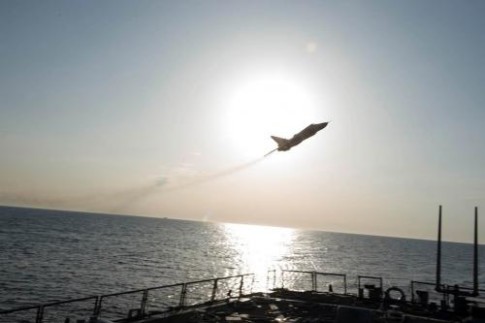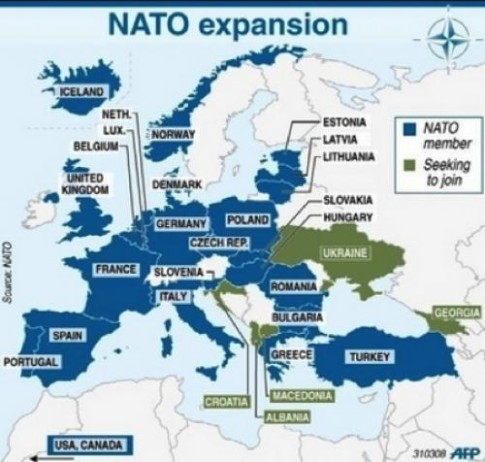– Russia Threatens U.S., Will Respond With “All Necessary Means” To Any NATO Intimidation Attempts:
Last week, the US Navy and Air force were livid when Russian fighter jets first buzzed the US missile destroyer USS Donald Cook in the Baltic Sea, and just days later flew within 50 feet of a US recon plane also flying over the Baltic Sea, which some interpreted as a Russian warning to Poland. The U.S. escalated and complained vocally to Russia (even if Obama did not mention the incident during his phone call with Putin last week).
However, if anyone was expecting Russia to politely apologize to the U.S. for last week’s two “flybys”, they would be drastically disappointed, because as Reuters reported overnight, it was Russia who accused the United States on Wednesday of intimidation by sailing a U.S. naval destroyer close to Russia’s border in the Baltics and warned that the Russian military would respond with “all necessary measures” to any future incidents.
Speaking after a meeting between NATO envoys and Russia, their first in almost two years, Moscow’s ambassador to NATO said the April 11 maritime incident showed there could be no improvement in ties until the U.S.-led alliance withdrew from Russia’s borders.
“This is about attempts to exercise military pressure on Russia,” the envoy, Alexander Grushko, said. “We will take all necessary measures, precautions, to compensate for these attempts to use military force,” he told reporters.
Earlier, U.S. Ambassador to NATO Douglas Lute pressed Russia about the incident, warning it had been dangerous. The United States has said the guided missile destroyer USS Cook was on routine business near Poland when it was harassed by Russian jets.
“We were in international waters,” a NATO diplomat reported Lute as telling Grushko during the NATO-Russia council meeting.
That is not how Russia saw it however. As a reminder, Russia has been quite vocal about NATO expanding ever closer to its borders, and in many ways the Russian action was perhaps to be expected following the striking announcement at the end of March that NATO had changed its Eastern European doctrine from “Assurance” to “Deterrence.”
Despite what officials said was a calm and professional meeting, the public comments highlighted the state of tension that persists between the two sides, and which escalated following the US-led presidential coup in Ukraine, followed by Moscow’s annexation of Crimea in March 2014, culminating with the resignation of Ukraine’s US puppet prime-minister Yatseniuk.
And while Russia’s chief concern has been NATO’s expansion and modernization since the Cold War, which is likely to include a military build-up in eastern Europe with a rotating, multinational force in Poland and the Baltics, NATO says its move is in direct response to previous Russian actions, alleging that the plans are a proportionate response to Russian aggression following Moscow’s annexation of Crimea, and the alliance had no forces in eastern Europe before the Ukraine crisis.
Poland and other NATO members in the Baltics worry about an increase in the Russian military presence in its Kaliningrad enclave, where Russia is positioning longer-range surface-to-air missiles. Ironically, when Russia positioned missiles in proximity to Poland in 2013, it stated that the move was once again in response to NATO expansion.
So while the narrative goes in circles, the military build ups on both sides continue, while “close call” incidents become increasingly frequent.
As Reuters adds, the session of the NATO-Russia Council, which last met in June 2014, had been called in part to assuage Russia’s concerns that it feels threatened by NATO. But core differences clearly remained afterwards. NATO envoys had expressed concern about Russia’s so-called snap exercises, where thousands of Russian troops carry out war games without any prior warning. “That is clearly destabilizing,” a NATO diplomat said, ignoring that NATO engages in comparable exercises.
Stoltenberg said NATO members had rejected Grushko’s description of the crisis in eastern Ukraine as a civil war. “In the meeting, it was re-confirmed that we disagree on the facts, on the narrative and the responsibilities in and around Ukraine,” Stoltenberg said after the meeting.
“Many allies disagree when Russia tries to portray this as a civil war. This is Russia destabilizing eastern Ukraine, providing support for the separatists, munitions, funding, equipment and also command and control,” he said.
“So there were profound disagreements,” he said.
However one wants to dub the Ukraine “situation”, one thing is clear: for a vast majority of Dutch voters, Ukraine’s entrance into an expanded European Union is a non-starter, which in effect kills the underlying stated public reason behind Ukraine’s “almost bloodless” revolution of 2014.
* * *
PayPal: Donate in USD
PayPal: Donate in EUR
PayPal: Donate in GBP

